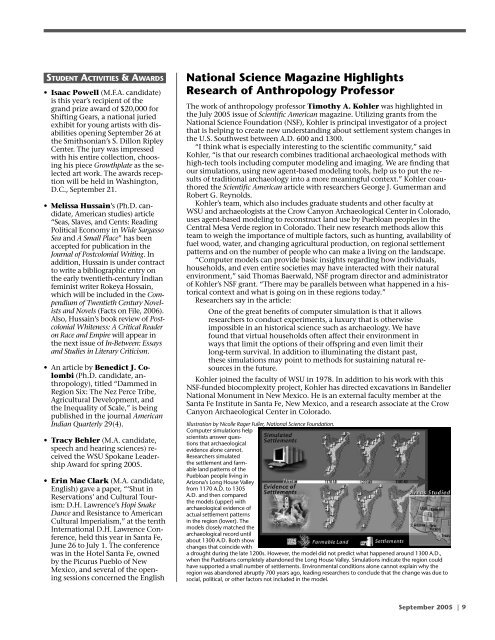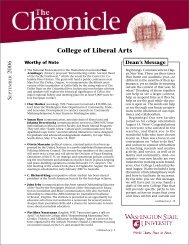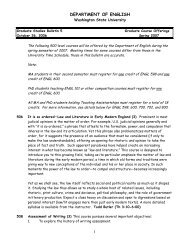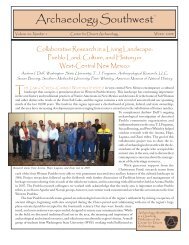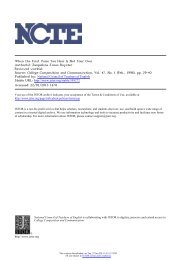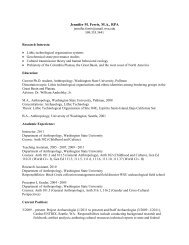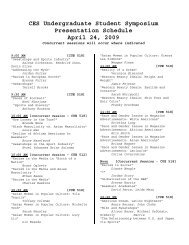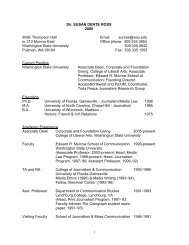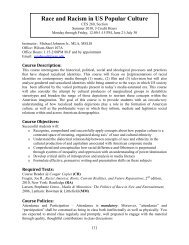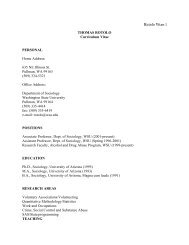College of Liberal Arts - College of Arts and Sciences - Washington ...
College of Liberal Arts - College of Arts and Sciences - Washington ...
College of Liberal Arts - College of Arts and Sciences - Washington ...
- No tags were found...
You also want an ePaper? Increase the reach of your titles
YUMPU automatically turns print PDFs into web optimized ePapers that Google loves.
STUDENT ACTIVITIES & AWARDS• Isaac Powell (M.F.A. c<strong>and</strong>idate)is this year’s recipient <strong>of</strong> thegr<strong>and</strong> prize award <strong>of</strong> $20,000 forShifting Gears, a national juriedexhibit for young artists with disabilitiesopening September 26 atthe Smithsonian’s S. Dillon RipleyCenter. The jury was impressedwith his entire collection, choosinghis piece Growthplate as the selectedart work. The awards receptionwill be held in <strong>Washington</strong>,D.C., September 21.• Melissa Hussain’s (Ph.D. c<strong>and</strong>idate,American studies) article“Seas, Slaves, <strong>and</strong> Cents: ReadingPolitical Economy in Wide SargassoSea <strong>and</strong> A Small Place” has beenaccepted for publication in theJournal <strong>of</strong> Postcolonial Writing. Inaddition, Hussain is under contractto write a bibliographic entry onthe early twentieth-century Indianfeminist writer Rokeya Hossain,which will be included in the Compendium<strong>of</strong> Twentieth Century Novelists<strong>and</strong> Novels (Facts on File, 2006).Also, Hussain’s book review <strong>of</strong> PostcolonialWhiteness: A Critical Readeron Race <strong>and</strong> Empire will appear inthe next issue <strong>of</strong> In-Between: Essays<strong>and</strong> Studies in Literary Criticism.• An article by Benedict J. Colombi(Ph.D. c<strong>and</strong>idate, anthropology),titled “Dammed inRegion Six: The Nez Perce Tribe,Agricultural Development, <strong>and</strong>the Inequality <strong>of</strong> Scale,” is beingpublished in the journal AmericanIndian Quarterly 29(4).• Tracy Behler (M.A. c<strong>and</strong>idate,speech <strong>and</strong> hearing sciences) receivedthe WSU Spokane LeadershipAward for spring 2005.• Erin Mae Clark (M.A. c<strong>and</strong>idate,English) gave a paper, “‘Shut inReservations’ <strong>and</strong> Cultural Tourism:D.H. Lawrence’s Hopi SnakeDance <strong>and</strong> Resistance to AmericanCultural Imperialism,” at the tenthInternational D.H. Lawrence Conference,held this year in Santa Fe,June 26 to July 1. The conferencewas in the Hotel Santa Fe, ownedby the Picurus Pueblo <strong>of</strong> NewMexico, <strong>and</strong> several <strong>of</strong> the openingsessions concerned the EnglishNational Science Magazine HighlightsResearch <strong>of</strong> Anthropology Pr<strong>of</strong>essorThe work <strong>of</strong> anthropology pr<strong>of</strong>essor Timothy A. Kohler was highlighted inthe July 2005 issue <strong>of</strong> Scientific American magazine. Utilizing grants from theNational Science Foundation (NSF), Kohler is principal investigator <strong>of</strong> a projectthat is helping to create new underst<strong>and</strong>ing about settlement system changes inthe U.S. Southwest between A.D. 600 <strong>and</strong> 1300.“I think what is especially interesting to the scientific community,” saidKohler, “is that our research combines traditional archaeological methods withhigh-tech tools including computer modeling <strong>and</strong> imaging. We are finding thatour simulations, using new agent-based modeling tools, help us to put the results<strong>of</strong> traditional archaeology into a more meaningful context.” Kohler coauthoredthe Scientific American article with researchers George J. Gumerman <strong>and</strong>Robert G. Reynolds.Kohler’s team, which also includes graduate students <strong>and</strong> other faculty atWSU <strong>and</strong> archaeologists at the Crow Canyon Archaeological Center in Colorado,uses agent-based modeling to reconstruct l<strong>and</strong> use by Puebloan peoples in theCentral Mesa Verde region in Colorado. Their new research methods allow thisteam to weigh the importance <strong>of</strong> multiple factors, such as hunting, availability <strong>of</strong>fuel wood, water, <strong>and</strong> changing agricultural production, on regional settlementpatterns <strong>and</strong> on the number <strong>of</strong> people who can make a living on the l<strong>and</strong>scape.“Computer models can provide basic insights regarding how individuals,households, <strong>and</strong> even entire societies may have interacted with their naturalenvironment,” said Thomas Baerwald, NSF program director <strong>and</strong> administrator<strong>of</strong> Kohler’s NSF grant. “There may be parallels between what happened in a historicalcontext <strong>and</strong> what is going on in these regions today.”Researchers say in the article:One <strong>of</strong> the great benefits <strong>of</strong> computer simulation is that it allowsresearchers to conduct experiments, a luxury that is otherwiseimpossible in an historical science such as archaeology. We havefound that virtual households <strong>of</strong>ten affect their environment inways that limit the options <strong>of</strong> their <strong>of</strong>fspring <strong>and</strong> even limit theirlong-term survival. In addition to illuminating the distant past,these simulations may point to methods for sustaining natural resourcesin the future.Kohler joined the faculty <strong>of</strong> WSU in 1978. In addition to his work with thisNSF-funded biocomplexity project, Kohler has directed excavations in B<strong>and</strong>elierNational Monument in New Mexico. He is an external faculty member at theSanta Fe Institute in Santa Fe, New Mexico, <strong>and</strong> a research associate at the CrowCanyon Archaeological Center in Colorado.Illustration by Nicolle Rager Fuller, National Science Foundation.Computer simulations helpscientists answer questionsthat archaeologicalevidence alone cannot.Researchers simulatedthe settlement <strong>and</strong> farmablel<strong>and</strong> patterns <strong>of</strong> thePuebloan people living inArizona’s Long House Valleyfrom 1170 A.D. to 1305A.D. <strong>and</strong> then comparedthe models (upper) witharchaeological evidence <strong>of</strong>actual settlement patternsin the region (lower). Themodels closely matched thearchaeological record untilabout 1300 A.D. Both showchanges that coincide witha drought during the late 1200s. However, the model did not predict what happened around 1300 A.D.,when the Puebloans completely ab<strong>and</strong>oned the Long House Valley. Simulations indicate the region couldhave supported a small number <strong>of</strong> settlements. Environmental conditions alone cannot explain why theregion was ab<strong>and</strong>oned abruptly 700 years ago, leading researchers to conclude that the change was due tosocial, political, or other factors not included in the model.September 2005 | 9


